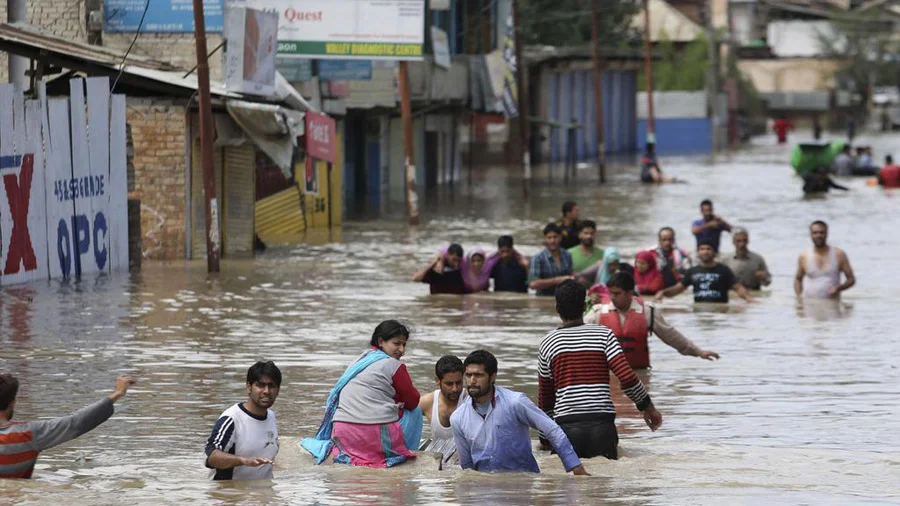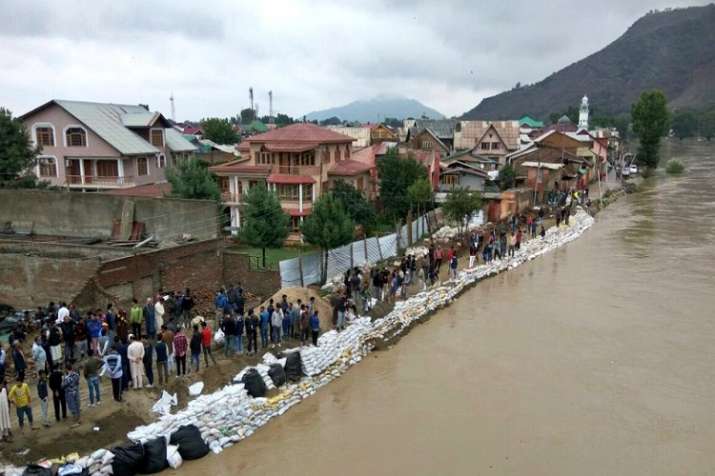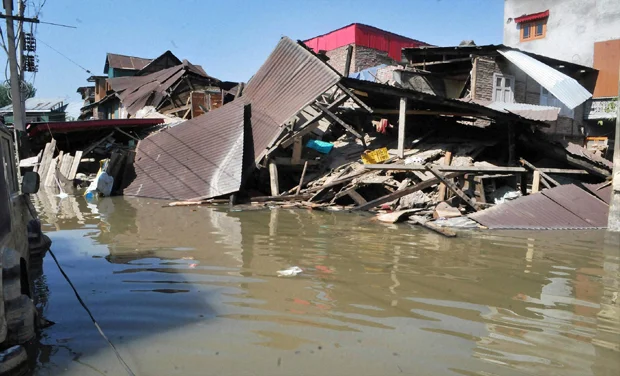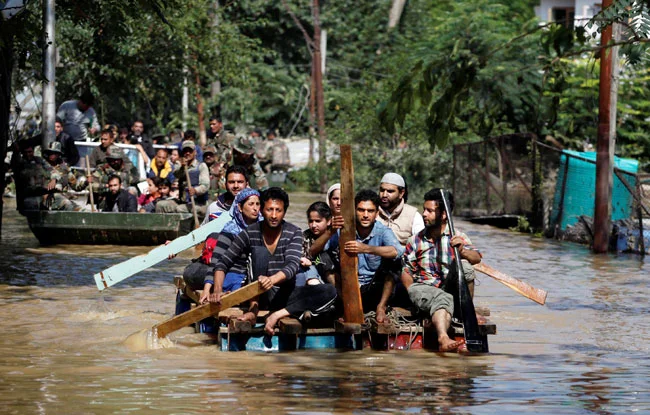
Last time when Jhelum went berserk and flooded major parts of the Valley, especially South Asia’s second oldest city, Srinagar, the Centre for Science and Environment (CSE) blamed a combination of intense rain, mismanagement, unplanned urbanization and a lack of preparedness for it. Six years later, Kashmir’s flood defense system continues to be an enigma.
WHEN the Central Water Commission (CWC) informed about the moderate risk of flash floods in some areas of Jammu and Kashmir on August 25, some haunting memories of the devastating fall of 2014 resurfaced on social media in Kashmir.
In the backdrop of the CWC’s prediction, many wondered: Is Kashmir staring at another deluge?
The forecast came on the eve of the sixth anniversary of the flood that marooned major parts of the valley, and ravaged lives and properties.
“Flash Flood Guidance issued by IMD valid for 6 hours from 0530 hrs on August 25, 2020, in Jammu and Kashmir and Uttarakhand are appended,” the CWC tweeted. “Moderate threat over some watersheds and neighborhood areas of Puch, Reasi and Ramban districts of Jammu and Kashmir…”
Flash Flood Guidance issued by IMD valid for 6 hours from 0530 hrs on 25th August 2020 in #J&K and Uttarakhand is appended pic.twitter.com/XthZcSvI3j
— Central Water Commission Official Flood Forecast (@CWCOfficial_FF) August 25, 2020
When flood hit Kashmir on September 6, 2014, thousands of people were left stranded inside their submerged houses. Due to incessant rain and overflowing flood channels, the conditions worsened in the following days.
By September 25 that year, the death toll had reached 285. Even after 10 days of the flood, three major hospitals remained closed, while two of them partially resumed their services.

The Centre for Science and Environment (CSE) stated that the 2014 floods in Kashmir were caused by “a combination of intense rain, mismanagement, unplanned urbanization and a lack of preparedness”.
Overlooked Warning
Six years before that shattering September, a stark warning had come in the form of a study.
Scientists Humayum Rashid and Gowhar Naseem, in their 2008-published paper, had warned that the breakdown of the natural discharge system due to the degradation of the network of lakes could prevent water from flowing out of the valley.
Though the proof of an upcoming flood was there, no steps were taken by the government — which was the first entity to disappear in the deluge.
“We completely forgot about floods after 1980,” Saleem Beg, convener at Indian National Trust for Art and Cultural Heritage (INTACH), said. “That’s why nothing much was done to get Kashmir prepared for floods.”
And such was the groundwork during the 2014 floods that there were no rescue boats in the initial days, Beg told Kashmir Observer.
Most of the infrastructure in the valley is in a flood-prone area, the INTACH convener continued.
“It’s a challenge for every government to remove construction from flood-prone areas but that cannot be a reason for bad disaster management,” he said.

A study done by Hakim Farooq Ahmad, Assistant Professor, Geography & Regional Development, University of Kashmir, clearly maps the flood vulnerability in the valley.
The study claims that 39 percent population, residing in 424 villages of the valley, with 90082 households, covering an area of 64.97% of study area, are vulnerable to low flood hazard.
Similarly, the professor notes, 41 percent population, belonging to 99 villages, with 110060 households, covering an area of 34.66% out of the total area of the study area, is vulnerable to moderate flood hazard in Kashmir.
“And about 20 percent population of 14 villages, with 55952 households, covering an area of only 0.35%, is highly vulnerable to flood hazard,” Prof Ahmad says.
Groundwork After 2014
Soon after the 2014 floods, New Delhi created an emergency project with the assistance of World Bank called Jhelum Tawi Flood Recovery Project (JTFRP).

The project focuses on “restoring critical infrastructure using international best practices on resilient infrastructure”.
Since Kashmir region is prone to both floods and earthquakes, JTFRF designs infrastructure with upgraded resilient features, and includes “contingency planning” for future disaster events.
Under JTFRP, the Multi-Hazard Risk Assessment Project (MHRA) for the entire erstwhile state of Jammu and Kashmir was given to RMSI, a GIS consulting company providing geospatial technology solutions.
The MHRA study is done with the aim to create disaster risk maps and associated outputs that will assist the J&K administration in building better and incorporating global frameworks.
According to Pushpender Johari, the team leader of MHRA, the assessment will be completed next year. The outcome will be used to develop a GIS-based Digital Risk Database (DRDB) and an Integrated Operational Forecasting System (IOFS), he informed.
“The RMSI team is testing DRDB and IOFS and plans to complete the full implementation by 2021,” Johari told Kashmir Observer. “The DRDB and IOFS will help to give warning to people ahead of the flood.”

The study will inform people about the increase in water level and the potential bridges that may get impacted, the project leader continued. “This will help in timely rescue and management.”
On being asked about the development of haphazard infrastructure in Kashmir, Johari said that many buildings in the valley are in flood-prone area especially the old constructions in Srinagar.
“Last time also it was the low-lying areas that were the most affected,” he said.
‘Situation Under Control’
Even as the CWC warning has renewed flood concerns in the valley, Iftikhar Kakroo, Chief Engineer of the Irrigation and Flood Control (IFC) Department, said that the situation is under control.
Notably, a flood is declared when the gauge reading at Sangam area in South Kashmir reaches 21.
All the officials, Kakroo said, have been asked to report the ‘mitigation process’ duty. “The officials are on 24×7 duty, and depending on their roles, they are assigned different tasks.”

The officials monitor the embankments to check if there is any threat of inundation that requires corrective action, the chief engineer told Kashmir Observer.
“Material required for strengthening embankment and plugging breach, like sand-filled bags and other machinery, is available with the department.”
Besides, he said, shelters are already identified by the district administration in wake of any contingency.
“To keep a track of the water levels and the amount of precipitation, automatic gauges are used by the department,” Kakroo said. “Everything is online and most of our sites are unmanned.”
But despite the IFC chief’s assurances, the common refrain in Kashmir remains that the official flood response is driven by the desperate times, desperate measures motto.
“After two-days of rainfall swelled Jhelum and created fresh flood concerns in the valley, the IFC is at its usual job again: Issuing gauge level updates,” said Syed Beenish, a Srinagar-based lawyer.
“It would’ve been far better for the IFC and its allied departments to work throughout to, at least, save the tormented Kashmiris from this regular mental pestering called flood anxiety.”
Follow this link to join our WhatsApp group: Join Now
Be Part of Quality Journalism |
Quality journalism takes a lot of time, money and hard work to produce and despite all the hardships we still do it. Our reporters and editors are working overtime in Kashmir and beyond to cover what you care about, break big stories, and expose injustices that can change lives. Today more people are reading Kashmir Observer than ever, but only a handful are paying while advertising revenues are falling fast. |
| ACT NOW |
| MONTHLY | Rs 100 | |
| YEARLY | Rs 1000 | |
| LIFETIME | Rs 10000 | |











